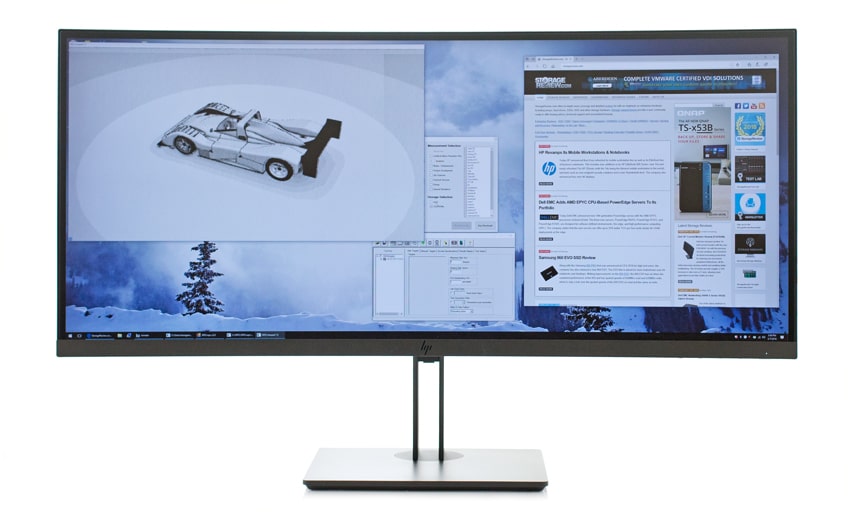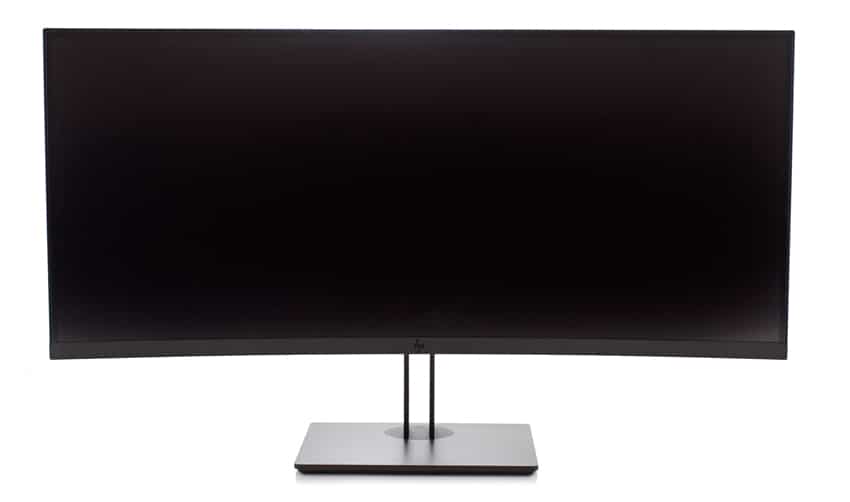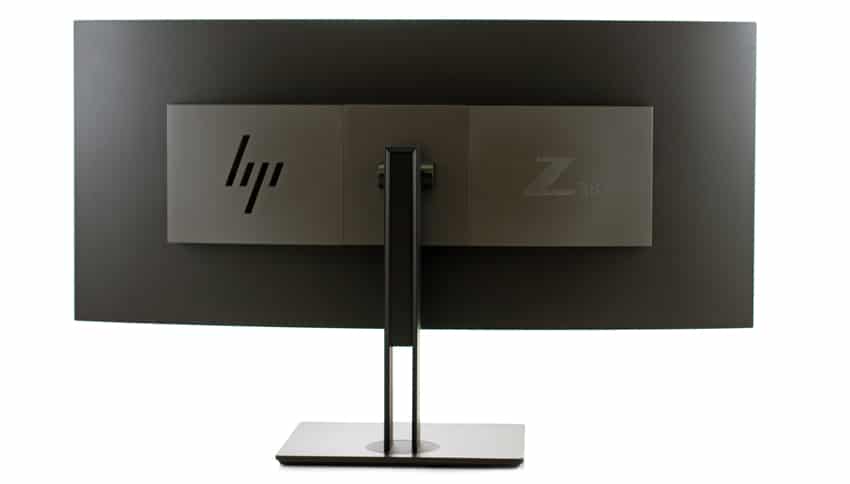
The new 37.5-inch HP Z38c Curved Display is HP’s widest curved monitor to date. It has an impressive 21:9 aspect ratio inside a very thin bezel, measuring just .25″ at the edge. Designed for media enthusiasts and professionals looking for a high-end monitor with a ton of real estate, the HP Z38c features one HDMI port, one DisplayPort 1.2 and a response time of 5ms. The new curved monitor also has USB-C charging capabilities for notebooks that support USB-C charging, so professionals only have to plug in one cable to use their monitor and charge at the same time.

HP’s Ultra-Wide Quad High Definition features a 4K-wide (3840×1600) resolution that features optimized pixel density so icons and text are the “ideal” size with full-screen support for lower resolutions. It also has factory-calibrated color right out of the box so professionals will have reliable and consistent color between displays with little to no setup.
HP Z38c Curved Display specifications
| Type: | 37.5-inch IPS, LED Backlit |
| Panel Type: | IPS |
| Resolution: | 3840 x 1600 @ 60Hz |
| Aspect Ratio: | 21:9 |
| Contrast Ratio (typical): | 1,000:1 |
| Dynamic Contrast Ratio (typical): | 5,000,000:1 |
| Response Time (typical): | 5ms Gray to Gray |
| Color Support: | Up to 1.07 billion colors with the use of FRC technology |
| Color Gamut: | 98% of sRGB |
| Anti-Glare: | Yes |
| Flicker Free: | Yes |
| Ports: |
DisplayPort:(1) DisplayPort 1.2
|
|
HDMI:(1) HDMI 2.0
|
|
|
USB Type-C:(1) USB Type-C
|
|
|
USB Version:3.0
|
|
|
Power Output Maximum PD 65w via USB Type-C
|
|
| Video Support USB-C Alt mode – DisplayPort 1.2 | |
| Monitor Features: | Tilt Range: –5° to + 20° vertical |
| Swivel Range:45°L to 45°R | |
| Display height adjustment: Adjustment Range: 120 mm |
Design and Build
The Z38c was quick and easy to setup. You simply have to insert the hooks at the top of the stand plate into the holes on the back of the monitor and move the stand toward the monitor until it clicks into place.
When put together, it’s immediately obvious that the Z38c is a very well-built, slick looking monitor highlighted by its attractive 3-sided micro edge bezel. Its matte finish also resists reflections very well. We have the Z38c placed on a desk situated in front of direct sunlight, and the resulting reflections/glares have had minimal impact. The footprint is fairly significant for a single monitor, so even large desk surfaces might need some re-adjusting to accommodate it. That being said, the Z38c is roughly the size of about two monitors and, compared to two monitors sitting on your desk, is more streamlined so it takes up less desk surface. The curved panel has some benefits as well. We’ve notice that if a face is centered in the monitor, it takes less effort going side to side compared to if the monitor was flat.
Moreover, its generous –5° to +20° tilt range, 45° left to 45° right swivel range and 4.7-inch height adjustment range, make the new Z38c is a very versatile display. We were able to easily maneuver the display for both a range a range of sitting and standing positions.
The display resolution has also been beneficial for our specific use case, as its very wide aspect ratio has helped immensely in our sysadmin roles at StorageReview. Our Lab Director’s current workflow uses 50/50 left to right, where he generally has ESXi management windows open on one side, while the other is web browser for webgui management of other devices or email.
The display’s functionality is easily accessed at the bottom right of the bezel. Many monitors have the buttons placed underneath the bezel, so it’s always a nice change to have them on the front of the monitor. From left to right is the Menu button, which opens and closes the OSD menu; three Function buttons, which navigate through the OSD menu based on what is shown above; and the Power button. The Z38c also is equipped with a standard VESA mounting adapter.
Once you’ve pressed the OSD menu button, you will see a wide range of menu choices including Brightness and Contrast, Color, Input, Image, Power and Menu controls, as well as Management, Language and Information options.
The HP display’s colors are bright and crisp, and the color temperature settings do offer a good selection depending on your viewing preferences. To this end, when pressing the Viewing Mode button, you have the option to change the display setting to low blue light mode, which reduces blue light for improved eye comfort; night mode, which adjusts to the lowest blue light to reduce the impact on sleep; and reading mode, which optimizes blue light and the brightness level for indoor viewing
Turning the monitor around reveals the plethora of the connectivity options, which are all located along the bottom. On the left is the master power switch and the AC power connector, the former which turns off all power to the monitor and will put it in the lowest power mode possible. Next is the HDMI and DisplayPort ports, an audio out jack and two USB Type-A (downstream) ports. There is also a security cable slot, so users can secure the display to a stationary object.
On the side of the monitor is a USB Type-A port with battery charging 1.2 (downstream) and a USB Type-C port (upstream). It should be noted that the USB Type-C port will function as a USB upstream port if it’s connected to a USB Type-C device.
Usage
The Ultra-Wide Quad HD 4K resolution has offered many benefits to my workflow, offering plenty of screen space to handle web browswers, Putty sessions, Word Documents, VMware clients and other administrative tools floating around all at the same time. You get the benefits of having two monitors worth of space with no interruption and fewer things need to be moved into the background. This has helped our lab director’s workflow quite a bit, where he’s able to glace at and monitor background activities via side vision, while working on other tasks. This is in contract to constantly having to pop a window up from the background to check how tasks are moving along. The only negative issue we ran into at times, are certain applications broke or got really weird moving to a full-size window. We had one storage device’s management portal snap to ant-size columns after it went full-size due to it not being prepared to handle the high resolutions the Z38c offers.
The LCD panel has been a joy to use throughout the review. The soft-matte finish with its anti-reflective coating has kept reflections at bay, which says a lot given there is a window directly behind this workstation. Color quality has been fantastic using the Low Blue Light viewing mode, and eye strain throughut the work day has been minimized.
Conclusion
The HP Z38c curved monitor excels when it comes to improving workflows and productivity, offering a ton of real estate with its 37.5-inch screen; users can easily fit two windows (along with a few other smaller ones) on the screen. Though the display does take up a relatively large footprint, it does eliminate the need for two monitors, which undoubtedly takes up more space than one Z38c. HP’s monitor is also beautifully designed, offers a range of different mounting options and features a bright Ultra-Wide Quad High Definition 4K (3840×1600) resolution. This display quality and size comes a costly price point, however, as it starts at roughly $1,200.
Sign up for the StorageReview newsletter



